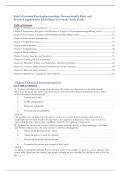Exam (elaborations)
Test Bank Stahl’s Essential Psychopharmacology 5th Edition
- Course
- Exams
- Institution
- Chamberlian School Of Nursing
Test Bank Stahl’s Essential Psychopharmacology 5th EditionTable of Contents Chapter 1 Chemical neurotransmission....................................................................................................................................... 1 Chapter 2 Transporters, Receptors, And Enzymes ...
[Show more]



